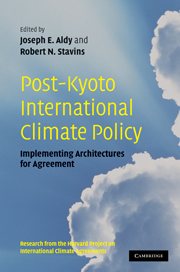Book contents
- Frontmatter
- Contents
- Harvard Environmental Economics Program, International Advisory Board
- Harvard Project on International Climate Agreements, Faculty Steering Committee
- Harvard Project on International Climate Agreements, Project Management
- List of figures
- List of tables
- List of contributors
- Foreword
- 1 Introduction
- Part I Alternative international policy architectures
- Part II Negotiation, assessment, and compliance
- Part III The role and means of technology transfer
- 13 International climate technology strategies
- 14 Mitigation through resource transfers to developing countries: expanding greenhouse gas offsets
- 15 Possible development of a technology clean development mechanism in a post-2012 regime
- Part IV Global climate policy and international trade
- Part V Economic development, adaptation, and deforestation
- Part VI Modeling impacts of alternative allocations of responsibility
- Part VII Synthesis and conclusion
- Appendix A Selected List of Individuals Consulted, Harvard Project on International Climate Agreements
- Appendix B Workshops and Conferences, Harvard Project on International Climate Agreements
- Glossary and Abbreviations
- Index
13 - International climate technology strategies
Published online by Cambridge University Press: 05 June 2012
- Frontmatter
- Contents
- Harvard Environmental Economics Program, International Advisory Board
- Harvard Project on International Climate Agreements, Faculty Steering Committee
- Harvard Project on International Climate Agreements, Project Management
- List of figures
- List of tables
- List of contributors
- Foreword
- 1 Introduction
- Part I Alternative international policy architectures
- Part II Negotiation, assessment, and compliance
- Part III The role and means of technology transfer
- 13 International climate technology strategies
- 14 Mitigation through resource transfers to developing countries: expanding greenhouse gas offsets
- 15 Possible development of a technology clean development mechanism in a post-2012 regime
- Part IV Global climate policy and international trade
- Part V Economic development, adaptation, and deforestation
- Part VI Modeling impacts of alternative allocations of responsibility
- Part VII Synthesis and conclusion
- Appendix A Selected List of Individuals Consulted, Harvard Project on International Climate Agreements
- Appendix B Workshops and Conferences, Harvard Project on International Climate Agreements
- Glossary and Abbreviations
- Index
Summary
Introduction
There is widespread agreement that achieving the very substantial reductions in greenhouse gas (GHG) emissions necessary to stabilize atmospheric carbon dioxide (CO2) concentrations at 450–550 parts per million (ppm) will require innovation and large-scale adoption of GHG-reducing technologies throughout the global energy system (IPCC 2007). The set of necessary technologies includes those for increased energy efficiency, renewable energy, nuclear power, and CO2 capture and storage. Alongside strategies aimed at reducing GHG emissions—such as emission targets in an international context or domestic GHG cap-and-trade systems or taxes—much discussion has therefore focused on policies that also target technology directly, including research and development (R&D) activities and technology-specific mandates and incentives. The associated policy debate is not so much over the importance of new technology per se in solving the climate problem, but rather over what the most effective policies and institutions are for achieving the dramatic technological changes necessary to stabilize GHG concentrations.
The scale of the system to be reoriented is immense. The International Energy Agency (IEA), in its most recent assessment of energy investment, projects that about $22 trillion of investment in energy-supply infrastructure will be needed over the 2006–2030 period, or almost $900 billion annually, on average (IEA 2007b). Note that this does not include expenditures on energy demand-side technologies (e.g., transportation, appliances, and equipment), which will measure in the trillions of dollars each year.
- Type
- Chapter
- Information
- Post-Kyoto International Climate PolicyImplementing Architectures for Agreement, pp. 403 - 438Publisher: Cambridge University PressPrint publication year: 2009
- 5
- Cited by



